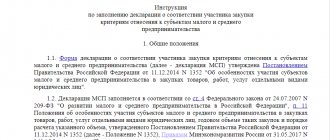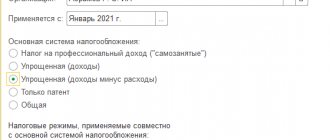In our country, the state focuses on the development of small businesses and regularly introduces various preferences for small enterprises, including micro-enterprises.
The purpose of today's publication is to consider the concept of a microenterprise from all economically significant points of view, evaluate its advantages and disadvantages, determine the criteria for classifying business entities as microenterprises and review other related applied issues.
Microenterprise concept
A microenterprise is one of the actively developing forms of small business.
It is understood as a business company (JSC, LLC), cooperative, peasant farm (peasant farm) or individual entrepreneur (IP), which meet certain criteria prescribed in the federal law on small business.
Based on these criteria, on August 1 of each year, existing businesses are entered into a special register.
There is no need to confirm this status with any documents; this happens automatically based on the submitted tax and statistical reports.
In 2021, Rosstat registered over 2.5 million such organizations.
You can find out whether any company is on this list on the Federal Tax Service website by searching by TIN, OGRN or initials of an individual entrepreneur.
Small and medium enterprises - criteria 2021
| Name of the normative criterion for a medium-sized enterprise | Limit value of the indicator | Legislative norm |
| Number of employees (average) for 2021 | · 101-250 people | Subp. 2 clause 1 stat. 4 of Law No. 209-FZ |
| The amount of profitability for 2021 - the indicator is calculated according to NU information by summing up data for the enterprise as a whole, that is, for all types of OKVED and taxation regimes | · 2000000000 rub. | Subp. 3 clause 1.1 of Law No. 209-FZ, Decree of the Government of Russia No. 265 of 04.04.16 |
| The total share of participation of the founders in the authorized/share capital or mutual fund of the company | This indicator is determined according to the rules given in the previous table, that is, for small companies | Subp. “a”, “e” subp. 1 clause 1.1 stat. 4 of Law No. 209-FZ |
The tables posted above contain the 2021 criteria for small and medium-sized businesses. In 2021, the Government of the Russian Federation adopted a number of changes regarding SMEs (Resolution No. 1412 of November 22, 2017), but this applies only to organizations operating in the field of light industry (codes of sections 13-15 of the OKVED Classifier). All other enterprises do not have to apply the norms of this document.
Microenterprise criteria
To be included in the micro-enterprise register in 2021, the enterprise must meet the following criteria:
- the share of the state, regions or municipalities in the authorized capital should not exceed 25%, and the share of foreign and large Russian companies should not exceed 49%;
- number of employees up to 15 people;
- financial income from business activities should not “exceed” the bar of 120 million rubles.
Income now includes not only sales revenue, but also income from other types of activities.
The amount of income is determined from income tax returns or special tax regimes, if any.
If one or more indicators are not achieved within three calendar years, the company will be excluded from the list of microenterprises, but not earlier than 08/10/2019.
Small business criteria 2021 – table
| Name of the regulatory criterion for a small enterprise | Limit value of the indicator | Legislative norm |
| Number of employees (average) for 2021 | · 15 people – for micro companies. · 16-100 people – for small enterprises | Subp. 2 clause 1 stat. 4 of Law No. 209-FZ |
| The amount of profitability for 2021 - the indicator is calculated according to NU information by summing up data for the enterprise as a whole, that is, for all types of OKVED and taxation regimes | · 120,000,000 rub. – for micro companies. · 800000000 rub. – for small enterprises. | Subp. 3 clause 1.1 of Law No. 209-FZ, Decree of the Government of Russia No. 265 of 04.04.16 |
| The total share of participation of the founders in the authorized/share capital or mutual fund of the company | · For an LLC – a maximum of 25% can be owned by the state, municipalities, constituent entities of the Russian Federation, charitable foundations or various religious/public structures. · For LLC – a maximum of 49% can be owned by foreign companies; enterprises that are not considered SMEs. · For JSC – a maximum of 25% of the shares participating in voting may be owned by the state, municipalities, constituent entities of the Russian Federation, charitable foundations or various religious/public structures. · For JSC - a maximum of 49% of the voting shares may be owned by foreign companies; enterprises not considered SMEs | Subp. “a”, “e” subp. 1 clause 1.1 stat. 4 of Law No. 209-FZ |
When determining whether a company is classified as a small enterprise, the greatest criterion for classification as a small enterprise in 2021 is selected (clause 3 of Article 4 of the Law). Let's assume the company has 45 people, which meets the conditions. But the income indicator for 2021 is equal to 900000000.00 rubles, which does not allow the LLC to be classified as a small enterprise.
Accounting statements of micro-enterprises
The management of a micro-enterprise has a lot of legal opportunities to optimize accounting. Its features depend on the chosen form of accounting.
There are several types of simplified accounting for small businesses.
[A]. In the full form, an organization uses many registers and accounts to maintain records. Records of liabilities and assets are kept in accordance with recommended forms.
This type of accounting makes sense to use if the organization carries out many different transactions.
To determine the tax base, it is advisable to use the accrual method.
[B]. Short form . If the company's operations are of a uniform nature, then there is no need to use a large number of accounts, and some homogeneous accounts can be combined into one.
For example, you can take into account on the twentieth account expenses not only for the main, but also for auxiliary production and general business expenses, and so on.
All transactions are recorded in one journal in chronological order by double entry.
It is recommended to use the K-1MP book for recording the facts of economic life as this journal.
It will also be useful to use the payroll slip (8MP).
To calculate the tax base, it is better to use the cash method.
[IN]. Simple form . Double entry does not apply.
Transactions are entered in chronological order into a single journal - “K-2MP” or “KUDiR” (book of income and expenses), if this is an individual entrepreneur or a simplified enterprise.
The chosen accounting method is fixed in the accounting policy, as well as the forms of the corresponding registers with the required details (name, name of the organization, dates, persons responsible for maintaining, etc.).
Small business – eligibility criteria 2021
To understand what small enterprises are, the criteria for 2021 must be studied according to the current Law No. 209-FZ of July 24, 2007 (hereinafter referred to as the Law). In accordance with paragraph 1 of stat. 3 SMEs are micro, small and medium-sized enterprises classified according to the criteria, including individual entrepreneurs and legal entities, economic entities, peasant farms and consumer and production cooperatives. The advantages of operating as a SME are obvious to already experienced businessmen.
According to Law No. 402-FZ of December 6, 2011, this is the possibility of using a simplified method of accounting and reporting. According to the Directives of the Central Bank No. 3210-U dated March 11, 2014, this means that there is no need to approve a limit on the cash balance at the cash desk. And according to Law No. 294-FZ of December 26, 2008, this is a “tax holiday” for scheduled inspections in general cases until the end of 2021. Who can be called an SMP subject?
The main criterion for classifying an enterprise as a small business is the number (average payroll) of the company's personnel. A complete list of mandatory conditions for obtaining SME status is contained in stat. 4 Laws. In addition to the already indicated criterion, among other necessary conditions, indicators of income and shares from the participation of the founders in the charter are named. The following are the current criteria for small and medium-sized businesses.
Small enterprises are organizations with a number of employees
Features of accounting for micro-enterprises
The accounting regulations (PBU) and other regulations provide for a number of relaxations for small businesses. Thus, a microenterprise has the right:
- recognize income and expenses based on the actual receipt or write-off of funds (cash method);
- to level out the difference between tax and accounting accounting when calculating income tax and not to create deferred tax assets and liabilities;
- do not use estimated liabilities (do not create reserves);
- do not correct errors retrospectively; you can do this in the month in which they were discovered; the resulting profit or loss is reflected in 91 accounts;
- take into account all borrowing costs as part of other expenses (account 91);
- make depreciation payments once a year (for other enterprises once a month);
- do not set a cash limit.
For reporting purposes, it is sufficient to submit a balance sheet and financial statements.
It is allowed to use simplified forms of these documents, in which individual articles are grouped into larger groups.
For example, only 5 indicators remain on the balance sheet assets, instead of 15 in full form: tangible and intangible assets, inventories, monetary and financial assets.
Small Business Inspections 2021
For such enterprises, shortened inspection periods apply. Any regulatory authority can inspect a small business entity for no longer than 50 hours per year. And for micro-enterprises the maximum period is 15 hours per year.
For 2 years (from January 1, 2021 to December 31, 2018), the “kids” were granted supervisory holidays. This benefit for small companies and individual entrepreneurs was established by Federal Law No. 246-FZ dated July 13, 2015. But this only applied to scheduled inspections. If a complaint is received from a consumer or government agencies have information about a company violating the law, inspectors will come with an audit.
The period of validity of the “supervisory holidays” established by Federal Law No. 246-FZ, which expired at the end of 2021, was extended for 2021 and 2021 by Federal Law No. 480-FZ of December 25, 2018, it was published on the official portal of legal documentation. However, it must be borne in mind that supervisory holidays do not apply to inspections carried out using the risk-based control method, and this method is used by such departments as the Federal Tax Service, the Ministry of Emergency Situations, the Federal Antimonopoly Service, Rosprirodnadzor, Rosalkogolregulirovanie and Rospotrebnadzor. From this we can conclude that small businesses are not exempt from inspections by these departments.
In addition, there will be no supervisory holidays for those enterprises that are engaged in licensed activities - these are:
- banks;
- insurers;
- Private security companies;
- subsoil users;
- pharmaceutical companies;
- carriers
and many others (a full list of 52 points is given in Article 12 of the Federal Law of May 4, 2011 N 99-FZ “On licensing of certain types of activities”).
Personnel records for micro-enterprises
From 01/01/2017 you can use simplified personnel document flow.
This means that the company is freed from the obligation to draw up local regulations, such as shift schedules, bonus provisions and others.
These points must be spelled out individually in a standard employment contract with each employee.
Instructions on labor protection at a micro-enterprise can be carried out by its manager.
Certification of workplaces is still required, except for remote and home workers.
If there is a need, employment contracts can be concluded for a period of up to 5 years; in general, such contracts are indefinite.
Video about personnel document flow of micro-enterprises:
Statistical reporting of micro-enterprises
Rosstat can conduct continuous and selective collection of data on companies.
In the first case, standard reporting is usually submitted:
- for individual entrepreneurs falling under the concept of a micro-enterprise, a report on the activities of 1 individual entrepreneur is submitted;
- information on key performance indicators - MP (micro);
- data on manufactured products - MP (micro)-nature;
From 2021, the TORG (micro) form has been abolished in retail trade, and form 1-alcohol has been abolished for those selling alcohol.
Rosstat may organize random checks and then you will have to submit additional reports.
You can find out whether any microenterprise is in the sample on the website of the State Statistics Service.
For violation of delivery deadlines, a fine of 20 to 70 thousand is provided for organizations, and for managers - from 10 to 20 thousand rubles.
The procedure for classifying a company as an SME
Organizations are not required to submit any supporting documents or information for inclusion in the SME register. Employees of control bodies, including the Federal Tax Service, automatically classify firms as small or medium-sized businesses. The basis is provided annually by certificates of headcount, tax return data, and information from the Unified Register. Lists of enterprises with SME status are posted on the federal portal of the Federal Tax Service.
The data is updated by tax officials no later than August 10th. The control date is July 1 (Article 6 of Law No. 408-FZ of December 29, 2015). Such a register is open information and is available for viewing by all interested parties. If all the required conditions are met, but the company is not on the list, it is recommended to submit an application to your Federal Tax Service office.
What can you learn from the SME register? In addition to the name of the company and its status, this is the date the company was included in the official register, TIN, and location address. In addition, this is information on the main workers of OKVED and the types of products (services, works). Additionally, this includes data on permits, including licenses, and information on participation in partnerships.



